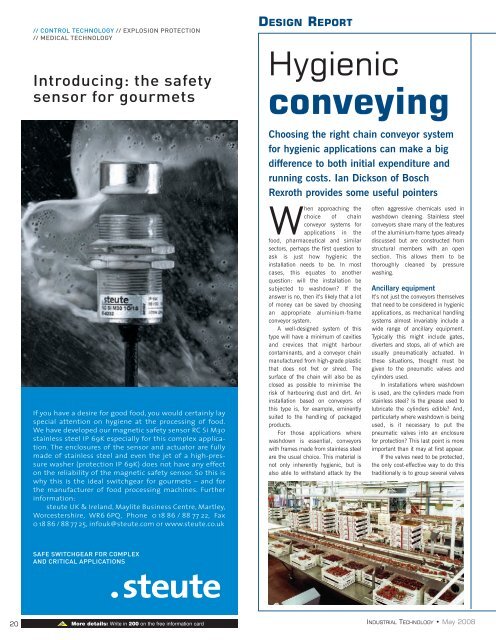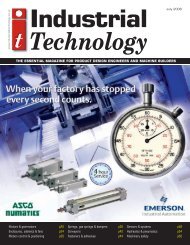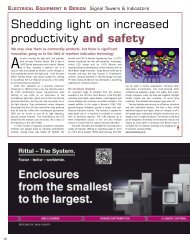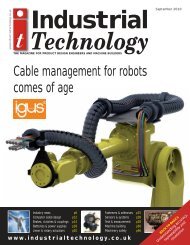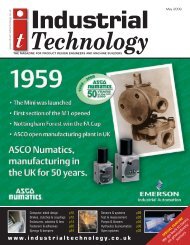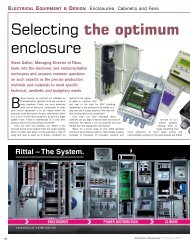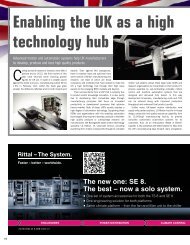sensors & systems - Industrial Technology Magazine
sensors & systems - Industrial Technology Magazine
sensors & systems - Industrial Technology Magazine
Create successful ePaper yourself
Turn your PDF publications into a flip-book with our unique Google optimized e-Paper software.
CONTROL TECHNOLOGY // EXPLOSION PROTECTION<br />
// MEDICAL TECHNOLOGY<br />
Introducing: the safety<br />
sensor for gourmets<br />
DESIGN REPORT<br />
Hygienic<br />
conveying<br />
Choosing the right chain conveyor system<br />
for hygienic applications can make a big<br />
difference to both initial expenditure and<br />
running costs. Ian Dickson of Bosch<br />
Rexroth provides some useful pointers<br />
If you have a desire for good food, you would certainly lay<br />
special attention on hygiene at the processing of food.<br />
We have developed our magnetic safety sensor RC Si M30<br />
stainless steel IP 69K especially for this complex application.<br />
The enclosures of the sensor and actuator are fully<br />
made of stainless steel and even the jet of a high-pressure<br />
washer (protection IP 69K) does not have any effect<br />
on the reliability of the magnetic safety sensor. So this is<br />
why this is the ideal switchgear for gourmets – and for<br />
the manufacturer of food processing machines. Further<br />
information:<br />
steute UK & Ireland, Maylite Business Centre, Martley,<br />
Worcestershire, WR6 6PQ, Phone 0 18 86 / 88 77 22, Fax<br />
0 18 86 / 88 77 25, infouk@steute.com or www.steute.co.uk<br />
When approaching the<br />
choice of chain<br />
conveyor <strong>systems</strong> for<br />
applications in the<br />
food, pharmaceutical and similar<br />
sectors, perhaps the first question to<br />
ask is just how hygienic the<br />
installation needs to be. In most<br />
cases, this equates to another<br />
question: will the installation be<br />
subjected to washdown? If the<br />
answer is no, then it’s likely that a lot<br />
of money can be saved by choosing<br />
an appropriate aluminium-frame<br />
conveyor system.<br />
A well-designed system of this<br />
type will have a minimum of cavities<br />
and crevices that might harbour<br />
contaminants, and a conveyor chain<br />
manufactured from high-grade plastic<br />
that does not fret or shred. The<br />
surface of the chain will also be as<br />
closed as possible to minimise the<br />
risk of harbouring dust and dirt. An<br />
installation based on conveyors of<br />
this type is, for example, eminently<br />
suited to the handling of packaged<br />
products.<br />
For those applications where<br />
washdown is essential, conveyors<br />
with frames made from stainless steel<br />
are the usual choice. This material is<br />
not only inherently hygienic, but is<br />
also able to withstand attack by the<br />
often aggressive chemicals used in<br />
washdown cleaning. Stainless steel<br />
conveyors share many of the features<br />
of the aluminium-frame types already<br />
discussed but are constructed from<br />
structural members with an open<br />
section. This allows them to be<br />
thoroughly cleaned by pressure<br />
washing.<br />
Ancillary equipment<br />
It’s not just the conveyors themselves<br />
that need to be considered in hygienic<br />
applications, as mechanical handling<br />
<strong>systems</strong> almost invariably include a<br />
wide range of ancillary equipment.<br />
Typically this might include gates,<br />
diverters and stops, all of which are<br />
usually pneumatically actuated. In<br />
these situations, thought must be<br />
given to the pneumatic valves and<br />
cylinders used.<br />
In installations where washdown<br />
is used, are the cylinders made from<br />
stainless steel? Is the grease used to<br />
lubricate the cylinders edible? And,<br />
particularly where washdown is being<br />
used, is it necessary to put the<br />
pneumatic valves into an enclosure<br />
for protection? This last point is more<br />
important than it may at first appear.<br />
If the valves need to be protected,<br />
the only cost-effective way to do this<br />
traditionally is to group several valves<br />
SAFE SWITCHGEAR FOR COMPLEX<br />
AND CRITICAL APPLICATIONS<br />
20 More details: Write in 200 on the free information card<br />
INDUSTRIAL TECHNOLOGY • May 2008


